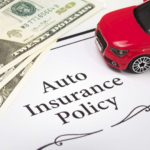Let’s face it—reading an auto insurance policy is like trying to decipher ancient hieroglyphics. The policy is replete with unfamiliar terms such as “deductibles,” “premiums,” and “liability coverage,” which may cause you to feel overwhelmed. But don’t worry; I’m here to break it all down into bite-sized chunks, sprinkled with a bit of humor to keep you awake.
So, grab a cup of coffee (or a snack, if you’re like me and believe in snacking during every activity), and let’s dive into the world of auto insurance, simplified!
What is auto insurance, and why do you need it?
Auto insurance serves as your financial safeguard when unexpected events disrupt your plans. It’s a contract between you and the insurance company. In return for your premium payment, the insurance company promises to assist in covering specific costs in the event of an accident or damage to your car.
Why do you need it?
- It’s legally required in most places. Driving without insurance is similar to entering a fancy party without an invitation—you’re likely to face expulsion (or fines).
- It protects your wallet. Car repairs and medical bills are expensive, and insurance can save you from dipping into your vacation fund (or your emergency chocolate stash).
- Peace of mind. Knowing you’re covered makes driving less stressful, even if you’re stuck in traffic behind someone who forgot how to use a turn signal.
- Types of Auto Insurance: What Are You Actually Paying For?
Think of auto insurance like a pizza—there are different slices (or coverage options), and you get to choose what you want.
1. Liability Insurance
This is the “mandatory” slice of the insurance pizza. It covers:
- Bodily Injury Liability: If you accidentally hurt someone, this covers their medical bills.
- Property Damage Liability: If you crash into someone’s car, mailbox, or prized garden gnome, this pays for the repairs or replacements.
It’s a funny thought: Liability insurance doesn’t cover you or your car—it’s like ordering pizza for everyone else and not getting your own slice.
2. Collision Coverage
This pays for your car repairs if you’re in an accident, regardless of who’s at fault.
For instance, what if you accidentally hit a pole during parallel parking? Don’t worry—collision coverage has your back.
3. Comprehensive coverage
This is the “everything else” coverage. It assists in mitigating damage resulting from theft, vandalism, natural disasters, or even an unexpected rogue deer.
The term “comprehensive” refers to its attempt to encompass all aspects, with the exception of your dubious choice to park beneath a tree teeming with birds.
4. Personal Injury Protection (PIP)
This covers medical expenses for you and your passengers, no matter who caused the accident.
5. Uninsured/Underinsured Motorist Coverage
This protects you in situations where the other driver’s insurance is insufficient or nonexistent.
How Do Premiums and Deductibles Work?
Your policy’s main components are the insurance premiums and deductibles. Let’s decode them:
Premiums
- This is the amount you pay (monthly, semi-annually, or annually) to keep your policy active.
- Factors affecting your premium include:
- Your driving history (yes, that speeding ticket from last summer matters) is important.
- Your age (younger drivers often pay more because, well, they’re statistically more accident-prone).
- The type of car you drive (a flashy sports car costs more to insure than your grandma’s minivan) affects the cost of insurance.
Deductibles
- This represents the out-of-pocket cost before insurance coverage begins.
- For example, if your deductible is $500 and repairs cost $2,000, you pay $500, and insurance covers the rest.
Pro tip: Choosing a higher deductible usually lowers your premium, but make sure you can afford it if something happens.
Common Myths About Auto Insurance (Debunked!)
Myth 1: Red Cars Cost More to Insure
Nope! Insurance companies don’t care about your car’s color. They care about its make, model, and year.
Myth 2: Older Cars Don’t Need Insurance
Even if your car is older, you still need liability insurance. Plus, if it’s valuable, you might want comprehensive and collision coverage too.
Myth 3: Insurance Covers Everything
Spoiler alert: It doesn’t. Make sure to carefully review the fine print to understand the contents.
How to Choose the Right Policy: A Step-by-Step Guide
Here’s a quick roadmap to help you navigate the insurance maze:
1. Assess Your Needs
- Do you drive daily or occasionally?
- Do you live in an area prone to natural disasters?
2. Compare quotes.
Shop around! Use online tools or work with an agent to find the best deal.
3. Check the Coverage Limits
Make sure your policy meets state requirements and covers your needs.
4. Ask about discounts.
- Good driver discounts
- Bundling home and auto insurance
- Student discounts
5. Read the Fine Print
Always review the terms to avoid surprises later.
A Quick Comparison Table
Here’s a snapshot of the main types of auto insurance:
| Coverage Type | What It Covers | Who It’s For |
|---|---|---|
| Liability | Others’ injuries and property damage | It is legally required for all drivers. |
| Collision | An accident causes damage to your car. | Drivers who want repair costs covered |
| Comprehensive | Theft, natural disasters, and vandalism | Anyone worried about non-accident damage |
| PIP | Medical expenses for you and passengers | States where it’s required |
| Uninsured Motorist | Damages caused by uninsured/underinsured drivers | Drivers in areas with high uninsured rates |
Tips to save money on auto insurance
Here are some practical ways to keep your costs low:
- Bundle your policies: Combine auto and home insurance for discounts.
- Drive safely: Avoid accidents and tickets.
- Opt for a higher deductible: Just make sure you can afford it.
- Take advantage of discounts: Many companies offer savings for excellent grades, safe driving, or even low mileage.
Final Thoughts: Drive with Confidence
Auto insurance doesn’t have to be confusing. Consider it as your protection against unforeseen events. By comprehending the fundamentals, evaluating your choices, and selecting the appropriate coverage, you can embark on your journey with a sense of security (and potentially, an additional financial boost).



